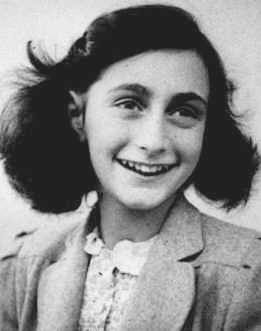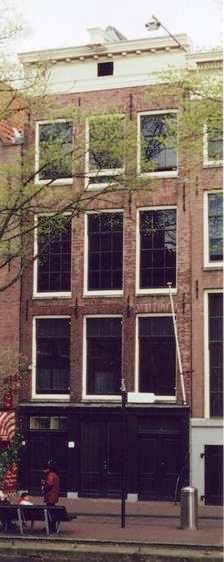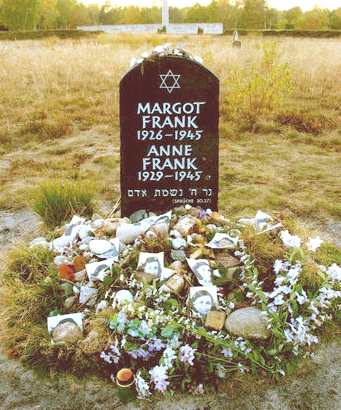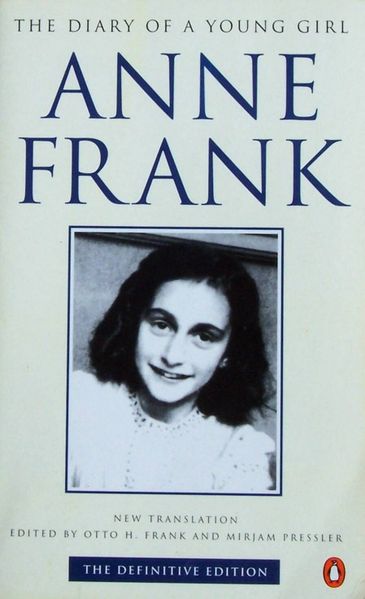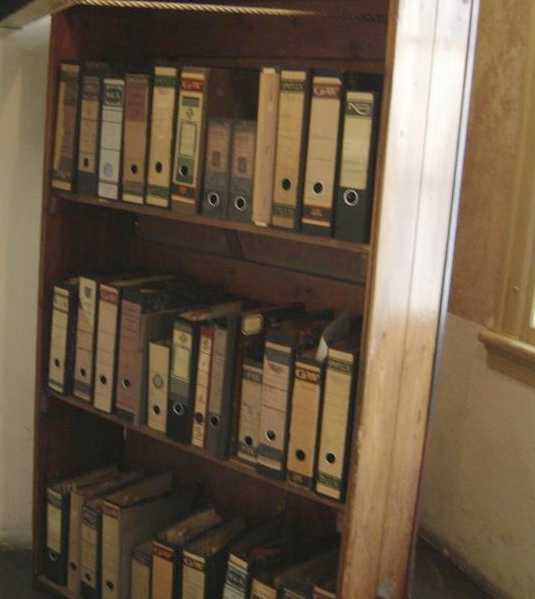|
ANNE FRANK'S DIARIES
|
|||
|
Anneliese Marie "Anne" Frank (June 12, 1929 – February/March, 1945) was a German-born Jewish girl who wrote a diary while in hiding with her family and four friends in Amsterdam during the German occupation of the Netherlands in World War II. Her family had moved to Amsterdam after the Nazis gained power in Germany but were trapped when the Nazi occupation extended into The Netherlands. As persecutions against the Jewish population increased, the family went into hiding in July 1942 in hidden rooms in her father Otto Frank's office building. After two years in hiding, the group was betrayed and transported to the concentration camp system where Anne died of typhus in Bergen-Belsen within days of her sister, Margot Frank. Her father, Otto, the only survivor of the group, returned to Amsterdam after the war ended, to find that her diary had been saved. Convinced that it was a unique record, he took action to have it published. It was published originally in English under the name The Diary of a Young Girl.
Anne Frank
The diary was given to Anne Frank for her thirteenth birthday and chronicles the events of her life from June 12, 1942 until its final entry of August 1, 1944. It was eventually translated from its original Dutch into many languages and became one of the world's most widely read books. There have also been several film, television, and theatrical productions, and even an opera, based on the diary. Described as the work of a mature and insightful mind, it provides an intimate examination of daily life under Nazi occupation; through her writing, Anne Frank has become one of the most renowned and discussed of the Holocaust victims.
Early life
Anne Frank was born on June 12, 1929 in Frankfurt am Main, Germany, the second daughter of Otto Heinrich Frank (May 12, 1889–August 19, 1980) and Edith Holländer (January 16, 1900–January 6, 1945). Margot Frank (February 16, 1926 – February/March, 1945) was her sister. Her given name was Anneliese Marie, but to her family and friends, she was simply "Anne". Her father sometimes called her "Annelein" ("little Anne").
The family lived in an assimilated community of Jewish and non-Jewish citizens, and the children grew up with Catholic, Protestant, and Jewish friends. The Franks were Reform Jews, observing many of the traditions of the Jewish faith without observing many of its customs. Edith Frank was the more devout parent, while Otto Frank, a decorated German officer from World War I, was interested in scholarly pursuits and had an extensive library; both parents encouraged the children to read.
On March 13, 1933, elections were held in Frankfurt for the municipal council, and Adolf Hitler's Nazi Party won. Anti-Semitic demonstrations occurred almost immediately, and the Franks began to fear what would happen to them if they remained in Germany. Later in the year, Edith and the children went to Aachen, where they stayed with Edith's mother, Rosa Holländer. Otto Frank remained in Frankfurt, but after receiving an offer to start a company in Amsterdam, he moved there to organise the business and to arrange accommodation for his family.
Otto Frank began working at the Opekta Works, a company which sold the fruit extract pectin, and found an apartment on the Merwedeplein (Merwede Square) in an Amsterdam suburb. By February 1934, Edith and the children had arrived in Amsterdam, and the two girls were enrolled in school - Margot in public school and Anne in a Montessori school. Margot demonstrated ability in arithmetic, and Anne showed aptitude for reading and writing. Her friend Hannah Goslar later recalled that from early childhood, Anne Frank frequently wrote, shielding her work with her hand, and refusing to discuss the content of her writing. These early writings have not survived. Anne and Margot were also recognized as highly distinct personalities, Margot being well mannered, reserved, and studious, while Anne was outspoken, energetic, and extroverted.
In 1938, Otto Frank started a second company in partnership with Hermann van Pels, a butcher, who had fled Osnabrück in Germany with his family. In 1939, Edith's mother came to live with the Franks, and remained with them until her death in January 1942. In May 1940, Germany invaded the Netherlands, and the occupation government began to persecute Jews by the implementation of restrictive and discriminatory laws, and the mandatory registration and segregation of Jews soon followed. Margot and Anne were excelling in their studies and had a large number of friends, but with the introduction of a decree that Jewish children could only attend Jewish schools, they were enrolled at the Jewish Lyceum.
The period chronicled in the diary
Before going into hiding
For her thirteenth birthday on June 12, 1942, Anne received a small notebook which she had pointed out to her father in a shop window a few days earlier. Although it was an autograph book, bound with red-and-white plaid cloth and with a small lock on the front, Anne had already decided she would use it as a diary. She began writing in it almost immediately, describing herself, her family and friends, her school life, boys she flirted with and the places she liked to visit in her neighbourhood. While these early entries demonstrate that, in many ways, her life was that of a typical schoolgirl, she also refers to changes that had taken place since the German occupation. Some references are seemingly casual and not emphasized. However in some entries Anne provides more detail of the oppression that was steadily increasing. For instance, she wrote about the yellow star which all Jews were forced to wear in public, and she listed some of the restrictions and persecutions that had encroached into the lives of Amsterdam's Jewish population.
In July 1942, Margot Frank received a call-up notice from the Zentralstelle für jüdische Auswanderung (Central Office for Jewish Emigration) ordering her to report for relocation to a work camp. Anne was then told of a plan that Otto had formulated with his most trusted employees, and which Edith and Margot had been aware of for a short time. The family was to go into hiding in rooms above and behind the company's premises on the Prinsengracht, a street along one of Amsterdam's canals.
Main façade of the Opekta building on the Prinsengracht 2002 - Otto Frank's offices were in the front of the building, with the Achterhuis in the rear
Life in the Achterhuis
On the morning of Monday, July 6, 1942, the family moved into the hiding place. Their apartment was left in a state of disarray to create the impression that they had left suddenly, and Otto Frank left a note that hinted they were going to Switzerland. The need for secrecy forced them to leave behind Anne's cat, Moortje. As Jews were not allowed to use public transport, they walked several kilometres from their home, with each of them wearing several layers of clothing as they did not dare to be seen carrying luggage. The Achterhuis (a Dutch word denoting the rear part of a house, translated as the "Secret Annex" in English editions of the diary) was a three-story space at the rear of the building that was entered from a landing above the Opekta offices. Two small rooms, with an adjoining bathroom and toilet, were on the first level, and above that a large open room, with a small room beside it. From this smaller room, a ladder led to the attic. The door to the Achterhuis was later covered by a bookcase to ensure it remained undiscovered. The main building, situated a block from the Westerkerk, was nondescript, old and typical of buildings in the western quarters of Amsterdam.
Victor Kugler, Johannes Kleiman, Miep Gies, and Bep Voskuijl were the only employees who knew of the people in hiding, and with Gies' husband Jan Gies and Voskuijl's father Johannes Hendrik Voskuijl, were their "helpers" for the duration of their confinement. They provided the only contact between the outside world and the occupants of the house, and they kept them informed of war news and political developments. They catered for all of their needs, ensured their safety and supplied them with food, a task that grew more difficult with the passage of time. Anne wrote of their dedication and of their efforts to boost morale within the household during the most dangerous of times. All were aware that if caught they could face the death penalty for sheltering Jews.
In late July, the Franks were joined by the van Pels family: Hermann, Auguste, and 16-year-old Peter, and then in November by Fritz Pfeffer, a dentist and friend of the family. Anne wrote of her pleasure at having new people to talk to, but tensions quickly developed within the group forced to live in such confined conditions. After sharing her room with Pfeffer, she found him to be insufferable, and she clashed with Auguste van Pels, whom she regarded as foolish. Her relationship with her mother was strained, and Anne wrote that they had little in common as her mother was too remote. Although she sometimes argued with Margot, she wrote of an unexpected bond that had developed between them, but she remained closest emotionally to her father. Some time later, after first dismissing the shy and awkward Peter van Pels, she recognised a kinship with him and the two entered a romance.
Anne spent most of her time reading and studying, while continuing to write and edit her diary. In addition to providing a narrative of events as they occurred, she also wrote about her feelings, beliefs and ambitions, subjects she felt she could not discuss with anyone. As her confidence in her writing grew, and as she began to mature, she wrote of more abstract subjects such as her belief in God, and how she defined human nature. She continued writing regularly until her final entry of August 1, 1944.
Arrest and concentration camps
On the morning of August 4, 1944, the Achterhuis was stormed by the German Security Police (Grüne Polizei) following a tip-off from an informer who was never identified. Led by Schutzstaffel Oberscharführer Karl Silberbauer of the Sicherheitsdienst, the group included at least three members of the Security Police. The occupants were loaded into trucks and taken for interrogation. Victor Kugler and Johannes Kleiman were taken away and subsequently jailed, but Miep Gies and Bep Voskuijl were allowed to go. They later returned to the Achterhuis, where they found Anne's papers strewn on the floor. They collected them, as well as several family photograph albums, and Gies resolved to return them to Anne after the war.
The members of the household were taken to the Gestapo headquarters where they were interrogated and held overnight. On August 5, they were transferred to the Huis van Bewaring (House of Detention), an overcrowded prison on the Weteringschans. Two days later the eight Jewish prisoners were transported to Westerbork, The Netherlands. Ostensibly a transit camp, by this time more than 100,000 Jews had passed through it. Having been arrested in hiding, they were considered criminals and were sent to the Punishment Barracks for hard labour.
On September 3, the group was deported on what would be the last transport from Westerbork to the Auschwitz concentration camp. They arrived after a three days' journey, and were separated by gender, with the men and women never to see each other again. Of the 1019 passengers, 549 people – including all children under the age of fifteen years - were selected and sent directly to the gas chambers where they were killed. Anne had turned fifteen three months earlier and was spared, and although everyone from the Achterhuis survived this selection, Anne believed her father had been killed.
Memorial for Anne and Margot Frank at the former Bergen-Belsen site along with floral and pictorial tributes
With the other females not selected for immediate death, Anne was forced to strip naked to be disinfected, had her head shaved and was tattooed with an identifying number on her arm. By day, the women were used as slave labour; by night, they were crowded into freezing barracks. Disease was rampant and before long Anne's skin became badly infected by scabies.
On October 28, selections began for women to be relocated to Bergen-Belsen. More than 8,000 women, including Anne and Margot Frank and Auguste van Pels, were transported, but Edith Frank was left behind. Tents were erected to accommodate the influx of prisoners, Anne and Margot among them, and as the population rose, the death toll due to disease increased rapidly. Anne was briefly reunited with two friends, Hanneli Goslar (nicknamed "Lies" in the diary) and Nanette Blitz, who both survived the war. Blitz described her as bald, emaciated and shivering. Goslar said that although Anne was ill herself, she told her that she was more concerned about Margot, whose illness seemed to be more severe and who remained in her bunk, too weak to walk. Anne told both her friends that she believed her parents were dead.
In March 1945, a typhus epidemic spread through the camp killing an estimated 17,000 prisoners. Witnesses later testified that Margot fell from her bunk in her weakened state and was killed by the shock, and that a few days later Anne was dead too. They estimated that this occurred a few weeks before the camp was liberated by British troops on April 15, 1945, and although the exact dates were not recorded, it is generally accepted to have been between the end of February and the middle of March.
After the war, it was estimated that of the 110,000 Jews deported from the Netherlands during the Nazi occupation, only 5,000 of them survived.
The individual fates of the other occupants of the Achterhuis, their helpers, and other people associated with Anne Frank, are discussed further.
The Diary of A Young Girl
Publication of the diary
Otto Frank survived and returned to Amsterdam. He was informed that his wife had died and his daughters had been transferred to Bergen-Belsen. Although he remained hopeful that they had survived, the Red Cross in July 1945 confirmed the deaths of Anne and Margot. It was only then that Miep Gies gave him the diary. Otto read it and later commented that he had not realised Anne had kept such an accurate and well-written record of their time together. Moved by her repeated wish to be an author, he began to consider having it published. When asked many years later to recall his first reaction he said simply, "I never knew my little Anne was so deep".
Anne's diary began as a private expression of her thoughts and she wrote several times that she would never allow anyone to read it. She candidly described her life, her family and companions, and their situation, while beginning to recognise her ambition to write fiction for publication. In the spring of 1944, she heard a radio broadcast by Gerrit Bolkestein - a member of the Dutch government in exile—who said that when the war ended, he would create a public record of the Dutch people's oppression under German occupation. He mentioned the publication of letters and diaries, and Anne decided to submit her work when the time came. She began editing her writing, removing sections and rewriting others, with the view to publication. Her original notebook was supplemented by additional notebooks and loose-leaf sheets of paper. She created pseudonyms for the members of the household and the helpers. The van Pels family became Hermann, Petronella, and Peter van Daan, and Fritz Pfeffer became Albert Düssell. Otto Frank used her original diary, known as "version A", and her edited version, known as "version B", to produce the first version for publication. He removed certain passages, most notably those which referred to his wife in unflattering terms, and sections that discussed Anne's growing sexuality. Although he restored the true identities of his own family, he retained all of the other pseudonyms.
He gave the diary to the historian Anne Romein, who tried unsuccessfully to have it published. She then gave it to her husband Jan Romein, who wrote an article about it, titled "Kinderstem" ("A Child's Voice"), published in the newspaper Het Parool on April 3, 1946. He wrote that the diary "stammered out in a child's voice, embodies all the hideousness of fascism, more so than all the evidence at Nuremberg put together". His article attracted attention from publishers, and the diary was published in 1947, followed by a second run in 1950. The first American edition was published in 1952 under the title Anne Frank: The Diary of a Young Girl. A play based upon the diary, by Frances Goodrich and Albert Hackett, premiered in New York City on October 5, 1955, and later won a Pulitzer Prize for Drama. It was followed by the 1959 movie The Diary of Anne Frank, which was a critical and commercial success. Over the years the popularity of the diary grew, and in many schools, particularly in the United States, it was included as part of the curriculum, introducing Anne Frank to new generations of readers.
In 1986, the Netherlands State Institute for War Documentation published the so-called "critical edition" of the diary. It includes comparisons from all known versions, both edited and unedited. It also includes discussion asserting its authentication, as well as additional historical information relating to the family and the diary itself.
In 1999, Cornelis Suijk - a former director of the Anne Frank Foundation and president of the U.S. Center for Holocaust Education Foundation-—announced that he was in the possession of five pages that had been removed by Otto Frank from the diary prior to publication; Suijk claimed that Otto Frank gave these pages to him shortly before his death in 1980. The missing diary entries contain critical remarks by Anne Frank about her parents' strained marriage, and shows Anne's lack of affection for her mother.
Some controversy ensued when Suijk claimed publishing rights over the five pages and intended to sell them to raise money for his U.S. Foundation. The Netherlands Institute for War Documentation, the formal owner of the manuscript, demanded the pages to be handed over. In 2000, the Dutch Ministry of Education, Culture and Science agreed to donate US$300,000 to Suijk's Foundation, and the pages were returned in 2001. Since then, they have been included in new editions of the diary.
Cover of the diary's "Definitive Edition", 1995. The photograph used is cropped from a school portrait of Anne Frank taken at the Montessori School in 1941
Praise for Anne Frank and the Diary
In her introduction to the diary's first American edition, Eleanor Roosevelt described it as "one of the wisest and most moving commentaries on war and its impact on human beings that I have ever read". The Soviet writer Ilya Ehrenburg later said: "one voice speaks for six million—the voice not of a sage or a poet but of an ordinary little girl." As Anne Frank's stature as both a writer and humanist has grown, she has been discussed specifically as a symbol of the Holocaust and more broadly as a representative of persecution. Hillary Rodham Clinton, in her acceptance speech for an Elie Wiesel Humanitarian Award in 1994, read from Anne Frank's diary and spoke of her "awakening us to the folly of indifference and the terrible toll it takes on our young," which Clinton related to contemporary events in Sarajevo, Somalia and Rwanda.
After receiving a humanitarian award from the Anne Frank Foundation in 1994, Nelson Mandela addressed a crowd in Johannesburg, saying he had read Anne Frank's diary while in prison and "derived much encouragement from it." He likened her struggle against Nazism to his struggle against apartheid, drawing a parallel between the two philosophies with the comment "because these beliefs are patently false, and because they were, and will always be, challenged by the likes of Anne Frank, they are bound to fail."
In her closing message in Melissa Müller's biography of Anne Frank, Miep Gies attempted to dispel what she felt was a growing misconception that "Anne symbolizes the six million victims of the Holocaust", writing: "Anne's life and death were her own individual fate, an individual fate that happened six million times over. Anne cannot, and should not, stand for the many individuals whom the Nazis robbed of their lives... But her fate helps us grasp the immense loss the world suffered because of the Holocaust."
The diary has also been praised for its literary merits. Commenting on Anne Frank's writing style, the dramatist Meyer Levin – who worked with Otto Frank on a dramatisation of the diary shortly after its publication – praised it for "sustaining the tension of a well-constructed novel", while the poet John Berryman wrote that it was a unique depiction, not merely of adolescence but of "the mysterious, fundamental process of a child becoming an adult as it is actually happening". Her biographer Melissa Müller said that she wrote "in a precise, confident, economical style stunning in its honesty". Her writing is largely a study of characters, and she examines every person in her circle with a shrewd, uncompromising eye. She is occasionally cruel and often biased, particularly in her depictions of Fritz Pfeffer and of her own mother, and Müller explains that she channelled the "normal mood swings of adolescence" into her writing. Her examination of herself and her surroundings is sustained over a lengthy period of time in an introspective, analytical and highly self critical manner, and in moments of frustration she relates the battle being fought within herself between the "good Anne" she wants to be, and the "bad Anne" she believes herself to be. Otto Frank recalled his publisher explaining why he thought the diary has been so widely read, with the comment "he said that the diary encompasses so many areas of life that each reader can find something that moves him personally".
In June 1999, Time Magazine published a special edition titled TIME 100: Heroes & Icons of the 20th Century. This is a list of the 20th century's hundred most influential politicians, artists, innovators, scientists and icons. Anne Frank was selected as one of the 'Heroes & Icons'. The writer Roger Rosenblatt, author of Children of War, wrote Anne Frank's entry. In the article he describes her legacy:
Denials and legal action
Efforts have been made to discredit the diary since its publication, and since the mid 1970s Holocaust denier David Irving has been consistent in his assertion that the diary is not genuine. Continued public statements made by such Holocaust deniers prompted Teresien da Silva to comment on behalf of Anne Frank House in 1999, "for many right-wing extremists (Anne) proves to be an obstacle. Her personal testimony of the persecution of the Jews and her death in a concentration camp are blocking the way to a rehabilitation of national socialism".
Since the 1950s, Holocaust denial has been a criminal offence in several European countries, including Germany, and the law has been used to prevent a rise in neo-Nazi activity. In 1959, Otto Frank took legal action in Lübeck against Lothar Stielau, a school teacher and former Hitler Youth member who published a school paper that described the diary as a forgery. The court examined the diary, and, in 1960, found it to be genuine. Stielau recanted his earlier statement, and Otto Frank did not pursue the case any further.
In 1958, Simon Wiesenthal was challenged by a group of protesters at a performance of The Diary of Anne Frank in Vienna who asserted that Anne Frank had never existed, and who told Wiesenthal to prove her existence by finding the man who had arrested her. He began searching for Karl Silberbauer and found him in 1963. When interviewed, Silberbauer readily admitted his role, and identified Anne Frank from a photograph as one of the people arrested. He provided a full account of events and recalled emptying a briefcase full of papers onto the floor. His statement corroborated the version of events that had previously been presented by witnesses such as Otto Frank.
In 1976, Otto Frank took action against Heinz Roth of Frankfurt, who published pamphlets stating the diary was a forgery. The judge ruled that if he published further statements he would be subjected to a 500,000 Deutschmark fine and a six months' jail sentence. Two cases were dismissed by German courts in 1978 and 1979 on the grounds of freedom of speech, as the complaint was not filed by an "injured party". The court ruled in each case that if a further complaint was made by an injured party, such as Otto Frank, a charge of slander could follow.
The controversy reached its peak with the arrest and trial of two neo-Nazis, Ernst Römer and Edgar Geiss, who were tried and found guilty of producing and distributing literature denouncing the diary as a forgery, following a complaint by Otto Frank. During their appeal, a team of historians examined the documents in consultation with Otto Frank, and determined them to be genuine. In 1978, as part of an appeal of the cases won against Römer and Geiss, the German Criminal Court Laboratory, the Bundeskriminalamt (BKA) was asked to examine the kind of paper and the types of ink used in the manuscript of the diary. Although its findings indicated that ink with which the diary was written had been in use during the war, the BKA also concluded that "the later corrections made on the loose-leaf pages were written in part in black, green and blue ballpoint pen," though the BKA did not give any specific details about these alleged ballpoint corrections. Deniers of the authenticity of the diary focussed in particular on this statement, as ballpoint pens did not become widely available until after the end of the World War II.
In 1986, the Dutch "Gerechtelijk Laboratorium" (State Forensic Science Laboratory) in Rijswijk conducted another extensive technical examination of the manuscript. Though the BKA was invited by the "Gerechtelijk Laboratorium" to indicate where on the loose-leaf pages it had found the "ballpoint corrections", the BKA was unable to point out a single example. The "Gerechtelijk Laboratorium" itself found only two slips of paper in ballpoint ink which had been inserted in Anne Frank's loose leaf manuscript. The Revised Critical Edition of the Diary of Anne Frank (published 2003) reproduces images (pages 167-171) of the two slips of paper, and in the chapter summarising the findings of the State Forensic Science Laboratory which analysed the materials, ink and handwriting in the manuscripts of Anne Frank, H.J.J. Hardy writes on the matter:
A footnote on this page adds:
With Otto Frank's death in 1980, the original diary, including letters and loose sheets, had been willed to the Netherlands Institute for War Documentation, who commissioned a forensic study of the diary through the Netherlands Ministry of Justice in 1986. They examined the handwriting against known exemplars and found that they matched, and determined that the paper, glue and ink were readily available during the time the diary was said to have been written. Their final determination was that the diary is authentic. On March 23, 1990, the Hamburg Regional Court confirmed its authenticity.
Nevertheless, Holocaust deniers have been persistent in their claims that the diaries were forged. In 1991, Robert Faurisson and Siegfried Verbeke produced a booklet titled: The Diary of Anne Frank: A Critical Approach. It claimed that Otto Frank wrote the diary, based on assertions that the diary contained several contradictions, that hiding in the Achterhuis would have been impossible, and that the style and handwriting of Anne Frank were not those of a teenager.
In December 1993, the Anne Frank House in Amsterdam and the Anne Frank Funds in Basle instigated a civil law suit in order to prohibit the further distribution of The Diary of Anne Frank: A Critical Approach in the Netherlands. On December 9, 1998, the Amsterdam District Court ruled in favour of the claimants, forbade any further denial of the authenticity of the diary and unsolicited distribution of publications to that effect, and imposed a penalty of 25,000-guilders per infringement.
Statue of Anne Frank, by Mari Andriessen outside the Westerkerk in Amsterdam
Legacy
On May 3, 1957, a group of citizens including Otto Frank established the Anne Frank Foundation in an effort to rescue the Prinsengracht building from demolition and to make it accessible to the public. Otto Frank insisted that the aim of the foundation would be to foster contact and communication between young people of different cultures, religions or racial backgrounds, and to oppose intolerance and racial discrimination.
The Anne Frank House opened on May 3, 1960. It consists of the Opekta warehouse and offices and the Achterhuis, all unfurnished so that visitors can walk freely through the rooms. Some personal relics of the former occupants remain, such as movie star photographs glued by Anne to a wall, a section of wallpaper on which Otto Frank marked the height of his growing daughters, and a map on the wall where he recorded the advance of the Allied Forces, all now protected behind Perspex sheets. From the small room which was once home to Peter van Pels, a walkway connects the building to its neighbours, also purchased by the Foundation. These other buildings are used to house the diary, as well as changing exhibits that chronicle different aspects of the Holocaust and more contemporary examinations of racial intolerance in various parts of the world. It has become one of Amsterdam's main tourist attractions, and is visited by more than half a million people each year.
In 1963, Otto Frank and his second wife Elfriede Geiringer-Markovits set up the Anne Frank Fonds as a charitable foundation, based in Basel, Switzerland. The Fonds raises money to donate to causes "as it sees fit". Upon his death, Otto willed the diary's copyright to the Fonds, on the provison that the first 80,000 Swiss francs in income each year was to be distributed to his heirs, and any income above this figure was to be retained by the Fonds to use for whatever projects its administrators considered worthy. It provides funding for the medical treatment of the Righteous Among the Nations on a yearly basis. It has aimed to educate young people against racism and has loaned some of Anne Frank's papers to the United States Holocaust Memorial Museum in Washington, D.C. for an exhibition in 2003. Its annual report of the same year gave some indication of its effort to contribute on a global level, with its support of projects in Germany, Israel, India, Switzerland, the United Kingdom and the United States.
Elementary schools in both Dallas, Texas (Dallas ISD) and in Philadelphia, Pennsylvania (School District of Philadelphia) have been named "Anne Frank Elementary School" for her.
The life and writings of Anne Frank has inspired a diverse group of artists and social commentators to make reference to her in literature, popular music, television, and other forms of media.
LINKS and REFERENCE
Main reading
The apartment block on the Merwedeplein where the Frank family lived from 1934 until 1942
Further reading
References:
MARITIME HISTORY
GENERAL HISTORY
Thanks to the many people who died in Nazi concentration camps in WW2, the European Convention of Human Rights came into being. Anne's diaries rise above the eugenics cruelty and persecution to shame the Nazi regime. She was crucified, but did more in death than she might have done had she lived. The trilogy of prison diaries above tell a similar tale, but thanks to the Human Rights court, this story may end justly - but in any event, just like Ms Frank the story shames a system that causes outrageous loss of time for its imperfections.
|
|||
|
AUTOMOTIVE | EDUCATION | BLUEPLANET | SOLAR CAR RACING TEAMS | SOLAR CAR RACING TEAMS | SOLAR CARS |
|||
|
This
website is copyright © 1991- 2013 Electrick Publications. All rights
reserved. The bird logo |
